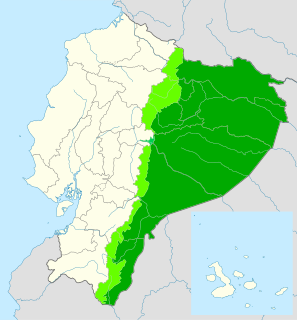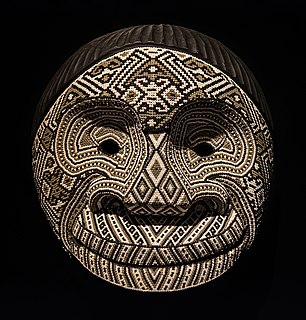Related Research Articles

Ecuador, officially the Republic of Ecuador, is a country in northwestern South America, bordered by Colombia on the north, Peru on the east and south, and the Pacific Ocean on the west. Ecuador also includes the Galápagos Islands in the Pacific, about 1,000 kilometers (621 mi) west of the mainland. The capital is Quito.

Ecuadorians are the people of Ecuador.

Putumayo is a department of Southern Colombia. It is in the south-west of the country, bordering Ecuador and Peru. Its capital is Mocoa.

Loreto is Peru's northernmost department and region. Covering almost one-third of Peru's territory, Loreto is by far the nation's largest department; it is also one of the most sparsely populated regions due to its remote location in the Amazon Rainforest. Its capital is Iquitos.

Sucumbíos is a province in northeast Ecuador. The capital and largest city is Nueva Loja. It is the fifth largest province in the country, with an area of 18,084 km2. In 2010, it had a population of 176,472 inhabitants.

The Aguarico River is a river in northeastern Ecuador. It is the main river of the Sucumbíos province. In the last part of its course it is the Ecuadorian-Peruvian border. It empties into the Napo River. It has a length of 390 km (240 mi), of which the last 50 km (31 mi) of its course extend along the natural border between Ecuador and Peru. The lower course of the Aguarico River was finalized and legally fixed as part of the long-disputed Ecuador-Peru frontier according to The Rio de Janeiro Protocol of 1942. Ecuador unilaterally denounced the protocol in 1960, however a new agreement was signed in 1999 validating the pre-existing protocol.

The Cofan people are an indigenous people native to Sucumbíos Province northeast Ecuador and to southern Colombia, between the Guamués River and the Aguarico River. Their total population is now only about 1,500 to 2,100 people, down from approximately 15,000 in the mid-16th century, when the Spanish crushed their ancient civilization, of which there are still some archeological remains. They speak the Cofán language or A'ingae. The ancestral land, community health and social cohesion of Cofan communities in Ecuador has been severely damaged by several decades of oil drilling. However, reorganization, campaigning for land rights, and direct action against encroaching oil installations have provided a modicum of stability. Major settlements include Sinangué, Dovuno, Dureno and Zábalo, the latter of which has retained a much more extensive land base.
The Secoya are an indigenous peoples living in the Ecuadorian and Peruvian Amazon. They speak the Secoya language Pai Coca, which is part of the Western Tucanoan language group. In Ecuador the Secoya number about 400 people who for the most part are located in three settlements, Eno, San Pablo de Katitsiaya and Siecoya Remolino, all found on the banks of the Aguarico river. Their Ecuadorian territory covers 40.000 hectares along the Shushufindi, Aguarico, and Cuyabeno river in the state of Sucumbios. Until recently they shared territory with the Siona people, with whom they are sometimes considered a single population, although both peoples have independent governance. In Peru the Secoya population numbers about 700.
The Teteté were a small group of Western Tucanoan speakers, who once lived in the Ecuadorian Amazon or Oriente. Today, their territory would lie within Ecuador’s Cuyabeno Wildlife Reserve, a popular site for ecotourism. From 1877 through the 1920s, however, Ecuadorian and Colombian rubber collectors (caucheros) and their native press gangs worked this part of the upper Aguarico and Putumayo watersheds, shooting or kidnapping Tetete people whenever they showed themselves. Sometime before 1940, most of the remaining Tetete were killed in a raid by neighboring Siona people. “On a sandbar, the two groups faced each other in long lines and began to fight. Very soon, the Siona won; a few Tetete escaped, others died, and several were wounded…Later, a Siona man found them fishing on Lake Cuyabeno, and they wounded him slightly in the shoulder…After that, we never saw them again.”. Large numbers of the Teteté were ultimately driven to extinction by missionaries and petroleum companies after oil exploration began nearby in 1964. The Ecuadorian Government officials have stated that the extinction of the Tetete people was partly caused by the encroachment of Texaco onto their land. The loss of hunting grounds to deforestation caused by oil expansion and subsequent oil contamination contributed to their extinction.
Cocama (Kokáma) is a language spoken by thousands of people in western South America. It is spoken along the banks of the Northeastern lower Ucayali, lower Marañón, and Huallaga rivers and in neighboring areas of Brazil and an isolated area in Colombia. There are three dialects. The robust dialect is known as Cocama, Kokama, Kukama-Kukamiria, Ucayali, Xibitaoan, Huallaga, Pampadeque, and Pandequebo. By 1999, Cocamilla (Kokamíya) was moribund, being only spoken by people over 40.

The Oriente is a region of eastern Ecuador, comprising the eastern slopes of the Ecuadorian Andes and the lowland areas of rainforest in the Amazon basin.

The Awá, also known as the Kwaiker or Awa-Kwaiker, are an ancient indigenous people of Ecuador and Colombia. They primarily inhabit the provinces of Carchi and Sucumbios in northern Ecuador and southern Colombia, particularly the departments of Nariño and Putumayo. Their population is around 32,555. They speak a language called Awa Pit.

The Cuyabeno Wildlife Reserve is the second largest reserve of the 56 national parks and protected areas in Ecuador. It is located in the Putumayo Canton in the Sucumbíos Province and in the Aguarico Canton in the Orellana Province. It was decreed on 26 July 1979 as part of the creation of the national protected areas system based on the recommendations of the FAO report on the "National Strategy on the Conservation of Outstanding Wild Areas of Ecuador".

There is no single system of races or ethnicities that covers all modern Latin America, and usage of labels may vary substantially.
Siona is a Tucanoan language of Colombia and Ecuador. The language is essentially the same as Secoya, but speakers are ethnically distinct.

The Emberálisten (help·info), also known in the historical literature as the Chocó or Katío Indians are an indigenous people of Panama and Colombia. In the Emberá language, the word ẽberá can be used to mean person, man, or indigenous person, depending on the context in which it is used. There are approximately 33,000 people living in Panama and 50,000 in Colombia who identify as Emberá.

The Kamëntsá are an indigenous people of Colombia. They primarily live in the Sibundoy Valley of the Putumayo Department in the south of Colombia.
Ecuadorian Siona is spoken by the Siona people of Ecuador, and can be considered a dialect or variety of a larger Baicoca-Siecoca, or Siona-Secoya, language cluster. Ecuadorian Siona belongs to the Western Tukanoan language family.

The Colombianization of Leticia, Putumayo and Caquetá is the name used to designate a process of transculturation or acculturation of the areas recognized under the sovereignty of Colombia thanks to the Salomón-Lozano Treaty, with the purpose of transplanting Colombian cultural traditions, in replacement of those cultivated in Peru.
References
- ↑ Varga, P. (2007) Ecoturismo y Sociedades Amazonicas. Quito: Ediciones Abya-Yala.